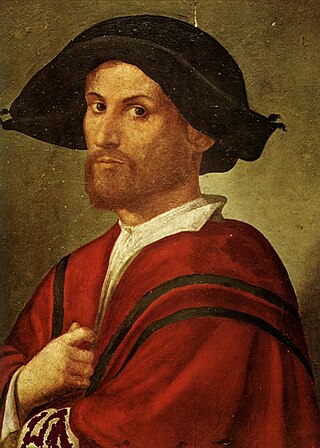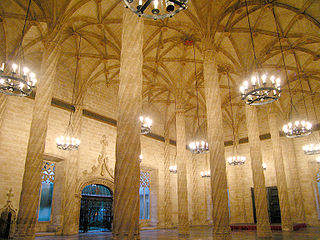
Francis Borgia was a Spanish Jesuit priest. The great-grandson of Pope Alexander VI, he was Duke of Gandía and a grandee of Spain. After the death of his wife, Borgia renounced his titles and became a priest in the Society of Jesus, later serving as its third superior general. He was canonized on 20 June 1670 by Pope Clement X.

Giovanni Borgia, 2nd Duke of Gandía (1476–1497) was the second born and the second son of Pope Alexander VI and Vannozza Cattanei and a member of the House of Borgia. He was the brother of Cesare, Gioffre, and Lucrezia Borgia. He was murdered on 14 June 1497. Even today, it is not known with certainty who was responsible for his death, although many at the time blamed his brother Cesare.

Elizabeth of Aragon, more commonly known as Elizabeth of Portugal, was queen consort of Portugal who is venerated as a saint in the Roman Catholic Church.

Duke of Gandía is a title of Spanish nobility that was first created in 1399 by Martin of Aragon and granted to Alfonso of Aragon and Foix. It has its origin in the lordship of Gandía created in 1323 by James II of Aragon. Later, having no direct descendants, the title passed from the House of Barcelona to the House of Trastámara.

Jerónima de la Asunción, O.S.C. was a Spanish Catholic nun and abbess who founded the Real Monasterio de Santa Clara in Intramuros, Manila, Philippines.

Chiara Offreduccio, known as Clare of Assisi, was an Italian saint and one of the first followers of Francis of Assisi.

The Monasterio de las Descalzas Reales is a monastery located in Valladolid, in Castile and León, Spain. Literally the Monastery of the Barefoot Royals, the name refers to the practice of the usage of the Colettine branch of the Order of St. Clare to be barefoot while within the cloister. This monastery is to be distinguished from a similarly named one in Madrid of the same Order.

Vallbona Abbey, otherwise the Monastery of Santa Maria de Vallbona, is a Cistercian nunnery in Vallbona de les Monges, in the comarca of Urgell, Catalonia, Spain. Founded in the early 12th century, and built between then and the 14th century, it is one of the most important monastic sites in Catalonia. Its church represents an example of transition between Romanesque and Gothic architecture. The abbey was declared a national monument on 3 June 1931.

The Monastery of Sant Jeroni de Cotalba is a monastic building of Valencian Gothic, Mudéjar, Renaissance, Baroque and Neoclassical styles constructed between the 14th and 18th centuries, located in the municipal area of Alfauir, (Valencia), Spain, about 8 km. from the well-known city of Gandia.

Pere Comte was a catalan architect from Girona. He was one of the main Gothic architects of the Crown of Aragon of the period, and in particular in Valencia, where he directed the construction of numerous palaces. Pere Compte is considered a master of the Valencian Gothic art.

Maria Enriquez de Luna was the wife of Juan (Giovanni) Borgia, second Duke of Gandia. Her father was, Enrique Enríquez de Quiñones, making her paternal grandfather Fadrique Enríquez. Her aunt, Juana Enríquez, was Queen of Aragon by marriage to John II of Aragon. Therefore, she was a first cousin of King Ferdinand II of Aragon and Queen Isabella of Castile, and therefore of the House of Trastamara. She married Juan somewhere between 1493 and 1494, and together, they had two children: Juan de Borja y Enriquez, who became the 3rd Duke of Gandía, and Isabel de Borja y Enriquez, who was born shortly after her father was killed and never knew him. The younger Juan was the father of Saint Francis Borgia. Isabel grew up to be abbess of Santa Clara in Gandia. In personality, Maria was very intelligent, devout, financially shrewd, and devoted to her husband and children, in contrast to her husband, who was regarded by many as a womanizer, a gambler, a drunkard, and an incompetent general.

The Route of the Borgias is a cultural route, that includes sites associated with the Borja or Borgia, located in their native Valencian Community, Spain. The marketing of the route was inaugurated in 2007.

Leonor de Castro Mello y Meneses was a Portuguese noble and court official, the Duchess of Gandía, and the lady-in-waiting and close friend of the Empress regent Isabella of Portugal.

The Route of the Valencian classics,, is a cultural route through the lands of the great classical writers of the Valencian literature of the Valencian Golden Age: Ausiàs March, Joanot Martorell and Joan Roís de Corella, the three related to the court of the Duke Alfonso of Aragon and Foix, "the Old".

Valencian Gothic is an architectural style. It occurred under the Kingdom of Valencia between the 13th and 15th centuries, which places it at the end of the European Gothic period and at the beginning of the Renaissance. The term "Valencian Gothic" is confined to the Kingdom of Valencia and its area of influence, which has its own characteristics.

Anna Maria Antigó i Pujol was a Catalan nun. Antigo was abbess of the convent St. Clair-de-la-Passion, in Perpignan, dedicated to the Poor Clares. She is best known for her work for peace in this community, her reform of the Poor Clares' convent, and for her influence in Catalonia and beyond. She is interred at St. Claire monastery, Perpignan. A beatification was initiated by the bishop of Perpignan, Jules de Carsalade du Pont, in 1909, but the process remained pending. Recognized as venerable, Antigo has a significant popular devotional following.

The Convento de Santa Clara la Real is a convent of the Poor Clares located in the city of Toledo, Castile-La Mancha, Spain. The present convent was founded in the middle of the 14th century by Toledan noblewoman María Meléndez, and is located near other monasteries of note, such as the monastery of Santo Domingo el Real and the Convent of Capuchins of Toledo.

The Convent of St. Clare is a former cloistered convent of the Order of Poor Clares, located in the city centre of Pontevedra, Spain, precisely in Santa Clara Street, near the disappeared St. Clare Gate of the medieval city walls. Founded in 1271, the convent closed in 2017. In 2021 the City Council bought the building from the Order, and in 2023 it transferred it to the Provincial Deputation to become part of the Pontevedra Museum.
Camilla Pio di Savoia was born an Italian noblewoman and later founded the first female monastery in Carpi, Italy, Santa Chiara, of which she was elected abbess. Her Cause for Canonization has been opened.

The Santa Clara Museum occupies the space of the church of the old Royal Convent of Santa Clara, completed in 1647. It is located in the Historic Center of Bogotá (Colombia), on Carrera 8 No. 8-91. It has an extensive collection of paintings and sculptures from the 17th, 18th, 19th and 20th centuries. The building is considered one of the most representative samples of the architecture and Baroque decoration of the 17th and 18th centuries in Bogotá. This museum is an entity of the Ministry of Culture.




















